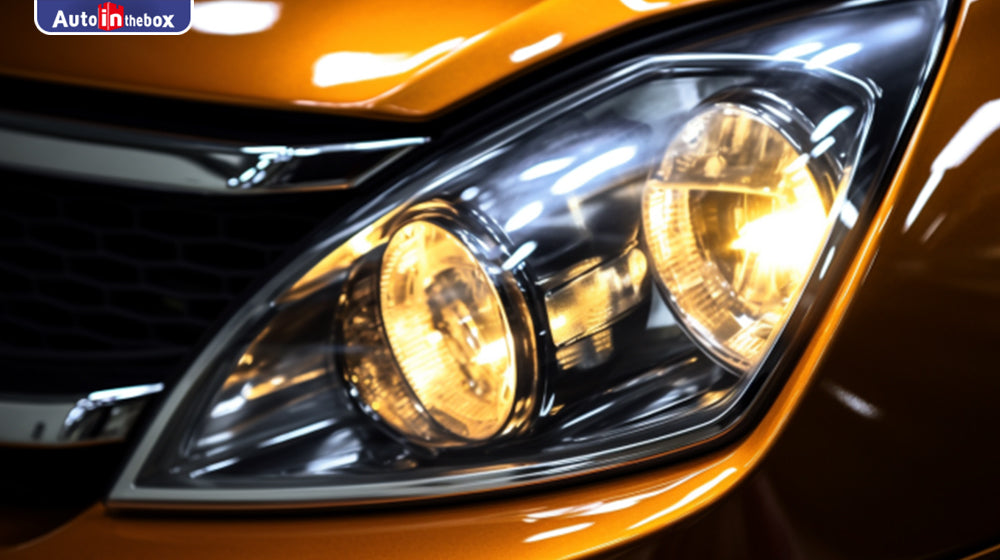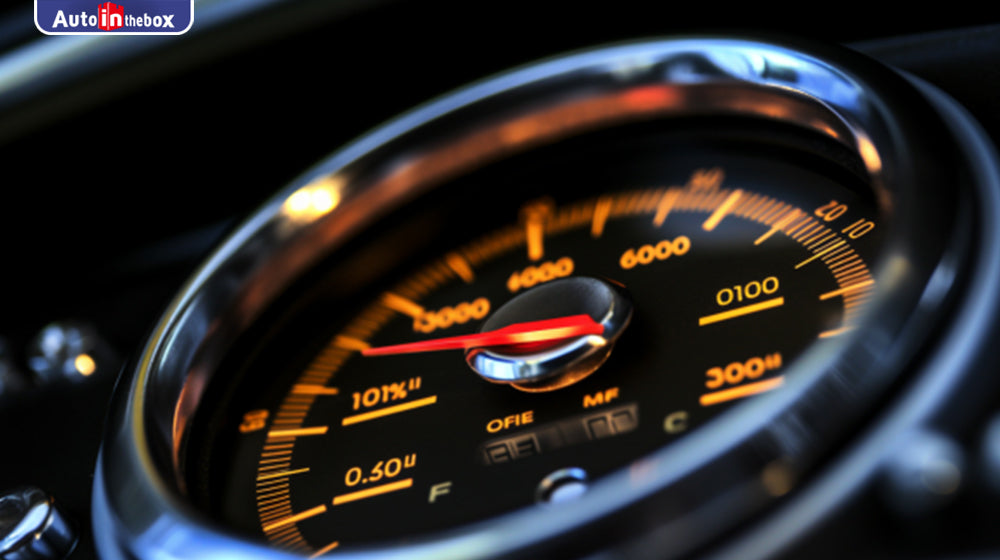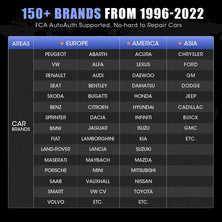
Why Headlights lights lose brightness?
Headlights are a vital component of a car, designed to ensure visibility during low-light conditions such as night time or adverse weather. They illuminate the road ahead, allowing drivers to see their path clearly and to be seen by other road users, thus playing a crucial role in road safety.
Recommended 2023 top car diagnostic tool:Launch IMMO plus,Launch pro5,Autel IM608II,Launch IMMO elite,Launch PADVII
To maintain the brightness of your headlights, it's important to regularly clean and inspect them, replace bulbs as needed, and ensure that the electrical system is in good working order.
Remember, regular maintenance and inspection of your headlights are crucial for road safety. If you notice any significant decrease in brightness, it's important to address the issue as soon as possible.
Given these risks, it's crucial to regularly check your headlights for any loss of brightness and address any issues as soon as possible.
Restoration and Repair:
Remember, maintaining the brightness of your headlights is not just about visibility, but also about safety. Regular maintenance and prompt repairs can help ensure that your headlights remain bright and effective.
It's important for drivers to familiarize themselves with the specific laws and regulations regarding headlights in their jurisdiction. Not only can failure to comply result in fines or other penalties, but it can also increase the risk of accidents.
These advancements aim to improve the safety and comfort of driving at night or in poor visibility conditions. As technology continues to evolve, we can expect to see even more innovative features in the future.
Recommended 2023 top car diagnostic tool:Launch IMMO plus,Launch pro5,Autel IM608II,Launch IMMO elite,Launch PADVII
There are several reasons why headlights might lose their brightness:
- Age and Usage: Over time, the components of a headlight can wear out, leading to a decrease in brightness. This is especially true for halogen bulbs, which have a filament that can degrade with use.
- Oxidation: The plastic cover of the headlight can become cloudy or yellowed due to exposure to sunlight and air, a process known as oxidation. This can reduce the amount of light that is able to pass through.
- Dirt and Debris: Dirt, dust, and other debris can accumulate on the surface of the headlights, obscuring the light and making them appear less bright.
- Electrical Issues: Problems with the vehicle's electrical system, such as a weak battery or issues with the wiring, can result in reduced power to the headlights, causing them to dim.
- Incorrect Alignment: If headlights are not properly aligned, the light may not be directed where it's most needed, making them seem less bright.
- Bulb Quality: Not all headlight bulbs are created equal. Lower quality bulbs may not be as bright or may lose their brightness more quickly than higher quality alternatives.
To maintain the brightness of your headlights, it's important to regularly clean and inspect them, replace bulbs as needed, and ensure that the electrical system is in good working order.
Detecting a loss in brightness of your headlights can be done through a few simple steps:
- Visual Inspection: The most straightforward method is to visually inspect the headlights. If they appear dimmer than usual, or if one light is noticeably dimmer than the other, there may be an issue.
- Wall Test: At night, park your car about 5 feet away from a flat wall with the headlights on. Observe the brightness of the light on the wall. If it appears dim or uneven, your headlights may be losing brightness.
- Reflection Test: Another method is to drive slowly towards a reflective surface, like a shop window or a shiny garage door, at night. Watch the reflection of your headlights. If they seem dimmer than usual, it might be a sign of reduced brightness.
- Road Test: While driving at night, pay attention to how well you can see the road ahead. If you're having difficulty seeing or if the road appears less illuminated than usual, your headlights might be dimming.
- Comparison Test: Compare your headlights to other cars. If your headlights seem significantly dimmer than other vehicles, it's likely that they're losing brightness.
- Professional Inspection: If you're unsure, consider having your headlights inspected by a professional. They have the tools and expertise to accurately measure the brightness of your headlights and can help identify any issues.
Remember, regular maintenance and inspection of your headlights are crucial for road safety. If you notice any significant decrease in brightness, it's important to address the issue as soon as possible.
The loss of brightness in car headlights can have several risks and impacts, primarily related to safety and visibility:
- Reduced Visibility: Dim headlights can significantly reduce a driver's visibility on the road, making it difficult to see obstacles, pedestrians, or other vehicles, especially in low-light conditions or bad weather.
- Increased Risk of Accidents: The reduced visibility can increase the risk of accidents. According to the National Safety Council, 50% of traffic deaths occur at night, despite only 25% of driving occurring after dark. Dim headlights can contribute to these statistics.
- Impaired Signaling: Headlights are not just for visibility; they also serve as a signal to other drivers. Dim headlights might not be as noticeable, making it harder for other drivers to see your vehicle, which can lead to dangerous situations.
- Legal Consequences: In many jurisdictions, there are legal requirements for headlight brightness. Driving with dim headlights could potentially lead to fines or other penalties.
- Increased Eye Strain: Driving with dim headlights can cause increased eye strain as drivers may need to focus more to see the road ahead. This can lead to fatigue and decreased alertness.
- Potential for More Serious Issues: Dim headlights could be a symptom of a more serious issue, such as an electrical problem in the vehicle. If left unchecked, this could lead to more significant problems down the line.
Given these risks, it's crucial to regularly check your headlights for any loss of brightness and address any issues as soon as possible.
Maintaining and repairing your headlights, as well as restoring their brightness, can be achieved through the following steps:
- Regular Cleaning: Dirt and debris can accumulate on the surface of the headlights, reducing their brightness. Regular cleaning with a suitable automotive cleaning solution can help maintain their clarity.
- Regular Inspection: Regularly inspect your headlights for any signs of damage, such as cracks or chips, and for any signs of dimming. Also, check the alignment of your headlights to ensure they are pointing in the right direction.
- Bulb Replacement: Over time, the bulbs in your headlights can wear out and become dim. Regularly replacing them can help maintain the brightness of your headlights. Always refer to your vehicle's manual for the correct type of bulb.
Restoration and Repair:
- Headlight Restoration Kits: If your headlights have become cloudy or yellowed due to oxidation, a headlight restoration kit can be used to restore their clarity. These kits usually include a polishing compound and a sealant to restore and protect the plastic.
- Professional Restoration Services: If the headlights are severely oxidized or damaged, it might be best to use a professional restoration service. They have the tools and expertise to restore your headlights to their original condition.
- Electrical Repairs: If the dimming is due to an electrical issue, such as a weak battery or faulty wiring, you may need to have these issues repaired by a professional.
Remember, maintaining the brightness of your headlights is not just about visibility, but also about safety. Regular maintenance and prompt repairs can help ensure that your headlights remain bright and effective.
Laws and regulations regarding the brightness of headlights vary by country and even by states or provinces within countries. However, there are some general principles that are commonly found in these regulations:
- Minimum and Maximum Brightness: Many jurisdictions have laws specifying the minimum and maximum brightness for headlights. These laws are designed to ensure that headlights are bright enough to illuminate the road effectively, but not so bright as to blind other drivers.
- Headlight Alignment: There are often laws requiring headlights to be properly aligned. Misaligned headlights can create dangerous glare for other drivers or fail to adequately illuminate the road.
- Use of High Beams: High beams are typically brighter than regular headlights and can create significant glare for other drivers. As such, there are often laws regulating when and where high beams can be used. For example, in many places, it is illegal to use high beams when approaching or following another vehicle within a certain distance.
- Headlight Maintenance and Repair: In many places, it is the driver's legal responsibility to ensure that their headlights are in good working order. This includes ensuring that the headlights are clean, that the bulbs are not burnt out, and that the headlights are not obscured by damage or modifications to the vehicle.
- Modifications: Any modifications to the headlights, such as changing the color or brightness, are often regulated. In many jurisdictions, it is illegal to use certain colors of headlights, and any modifications to increase the brightness may also be regulated.
It's important for drivers to familiarize themselves with the specific laws and regulations regarding headlights in their jurisdiction. Not only can failure to comply result in fines or other penalties, but it can also increase the risk of accidents.
The technology behind headlights is constantly evolving, with new advancements and trends emerging to improve visibility and safety. Here are some of the latest developments:
- LED Headlights: Light Emitting Diode (LED) headlights are becoming increasingly popular due to their energy efficiency, longevity, and brightness. They also allow for more flexibility in headlight design, as they can be made in a variety of shapes and sizes.
- Adaptive Headlights: These headlights adjust their beam pattern based on the vehicle's speed and steering. For example, when the vehicle turns, the headlights swivel to illuminate the road ahead. Some adaptive systems can also adjust the headlight beam to avoid dazzling oncoming drivers.
- Matrix LED Headlights: This technology allows individual LEDs within the headlight to be turned on and off or dimmed independently. This enables the vehicle to maintain high beam illumination without dazzling other road users, by selectively dimming LEDs that would otherwise shine in the eyes of oncoming drivers.
- Laser Headlights: Laser headlights are a newer technology that offers even greater brightness and range than LED or HID headlights. They work by using lasers to excite a phosphor, creating a bright, white light.
- Automatic High Beam Control: This technology automatically switches between high and low beams depending on the presence of other vehicles. This helps to maximize visibility without dazzling other drivers.
- Daytime Running Lights (DRLs): While not a new technology, the use of DRLs is becoming more widespread. These are lights that are on whenever the vehicle is running, designed to increase the visibility of the vehicle during daylight hours.
These advancements aim to improve the safety and comfort of driving at night or in poor visibility conditions. As technology continues to evolve, we can expect to see even more innovative features in the future.
Older Post
 Newer Post
Newer Post

Why my car windows blurry?

When Oil temperature of the engine is low? How to handle it?










